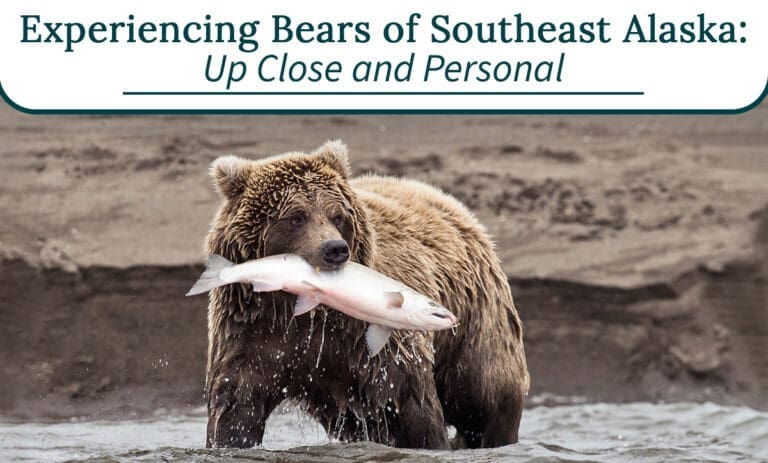
Alaska's wild beauty is unmatched, and nowhere is it more breathtaking than along the rugged coastlines near Auke Bay. Here, where dense forests meet rocky beaches and icy waters, one of the world's most awe-inspiring wildlife spectacles unfolds—the bears of Southeast Alaska. If you've ever dreamed of seeing these magnificent creatures in their natural habitat—and capturing their majesty through your lens—there is no better way to do it than aboard the Nordic Endeavor.
This isn't just a sightseeing trip. It's an immersion into the heart of Alaska's wilderness, and an opportunity to photograph wildlife with the kind of intimacy few ever experience.
Meet the Coastal Bears of Southeast Alaska
Southeast Alaska is home to two main species of bears: the American black bear (Ursus americanus) and the legendary brown bear (Ursus arctos), often called the coastal grizzly. Both species thrive here thanks to the abundance of salmon, lush vegetation, and the region's protected, wild landscapes.
The American Black Bear
Despite their name, black bears come in a range of colors, from black to cinnamon to even a blue-gray shade known as the rare "glacier bear," sometimes spotted near Auke Bay. Black bears are generally smaller than their brown counterparts, with adult males averaging 250–300 pounds. They are highly adaptable and can often be seen along shorelines flipping rocks for crabs, grazing on sedge grass, or feasting on salmon during spawning runs.
The Coastal Brown Bear
The coastal brown bear is a truly awe-inspiring sight. Much larger than black bears, males can weigh up to 1,200 pounds, especially after a summer of rich feeding. Southeast Alaska's coastal environment, rich in fish and plant life, allows these bears to grow bigger than their inland cousins. Watch for them patrolling the tide lines, hunting for fish, and feasting during salmon runs—a photographer's dream come true.
Why Southeast Alaska Is Perfect for Bear Viewing
The islands and coastal areas around Auke Bay offer a unique advantage: relatively low human population, thriving bear populations, and easy access by boat to remote and untouched locations. Unlike the crowded bear-viewing platforms you'll find deeper inland, the shores around Auke Bay offer a more authentic and peaceful experience, with the sounds of nature filling the air and breathtaking scenery providing the perfect backdrop for photographs.
Bears of Southeast Alaska are often less disturbed by human presence, meaning you have a higher chance of observing natural behaviors—playful cubs splashing in streams, dominant males defending prized fishing spots, and mothers teaching their young how to forage along the coast.
Tips for Photographing Coastal Bears of Southeast Alaska
Photographing wild bears is an incredible experience, but it requires preparation, respect, and an understanding of the environment. Here are essential tips to make your trip aboard the Nordic Endeavor unforgettable:
1. Bring the Right Gear
A telephoto lens is essential for photographing bears at a safe distance. A 300mm lens or longer will allow you to capture close-up shots without disturbing the animals. Also, consider a wide-angle lens to capture the stunning scenery surrounding the bears.
Be sure to bring:
- Extra memory cards
- Spare batteries (the cold can drain batteries quickly)
- A sturdy but portable tripod or monopod
- Lens cleaning supplies (Alaska's coastal mist can fog or splash your lenses)
2. Practice Patience
Wildlife photography is an exercise in patience. Bears may appear right away, or you might have to wait as they move through their coastal territory. The best photographs often come from simply observing quietly, allowing the bear to relax and act naturally.
3. Focus on Behavior, Not Just Portraits
While a full-frame shot of a bear's face is incredible, capturing behavior, like a bear catching a fish, playing with its cubs, or shaking off water, tells a richer story. Anticipate movements and have your camera ready to snap a series of shots when action happens.
4. Respect the Wildlife
Safety for both you and the bears is paramount. Always photograph from a distance and never attempt to approach bears. Aboard the Nordic Endeavor, you'll have the advantage of viewing bears from the water, giving you unique access to remote beaches without disturbing the wildlife.
5. Consider Light and Time of Day
The best times to photograph bears are early morning and late evening, when they are most active—and when the soft "golden hour" lighting bathes the landscape. Overcast days are also excellent for photography, minimizing harsh shadows and providing even, diffused light.
Witness the Bears of Southeast Alaska Aboard the Nordic Endeavor
What sets a chartered boat tour aboard the Nordic Endeavor apart from a typical wildlife excursion?
It's the freedom to explore hidden coves, untouched beaches, and wildlife-rich islands at your own pace, aboard a comfortable and capable vessel. You'll glide quietly along the shoreline, getting unparalleled access to prime bear-viewing spots that land-bound travelers can only dream of reaching.
The Nordic Endeavor is ideally suited for photographers of all levels—whether you're an amateur with a smartphone or a seasoned professional with a full DSLR setup. With the vessel as your platform, you'll have the stability to line up the perfect shot, the mobility to move as wildlife activity changes, and the peace and quiet that allows you to fully immerse yourself in Alaska's wild rhythms.
Every charter is a personalized adventure, meaning you can work with the captain to find the most promising bear-viewing areas based on the tides, salmon runs, and local knowledge. And along the way, you're likely to encounter much more than bears: bald eagles soaring overhead, humpback whales breaching in the distance, and seals lounging on rocky outcrops. Book your charter today and prepare to witness the bears of Southeast Alaska like never before. Your next extraordinary adventure begins here.